Table of Contents
Hypostomus Plecostomus Overview
The Hypostomus Plecostomus is a freshwater fish that is preferred by quite a number of aquarium hobbyists all around the world. The fish is native to the South American region although since it was introduced to the hobby, it has been distributed to various parts of Europe, Asia, and the Americas. It is also sometimes referred to as the suckermouth catfish for the way its mouth is uniquely made. Pleco has become popular among some aquarists because of its ornamental appearance. It is highly tolerant to a wide range of habitats and will easily adapt to new waters. It is classified as a highly invasive fish with the potential to cause widespread invasion when introduced to areas it did not exist before.
There are just so many characteristics that the fish possess that enable them to be invasive and also to survive in a wide range of habitats. Their bodies are well protected, they build nests where they keep their eggs and guard the eggs, and the fish also have the capability to breathe air when conditions get hypoxic. With these characteristics, the fish are surely able to get well in varied habitats where most aquarium fish may not even survive.
| Information Chart | Hypostomus Plecostomus |
|---|---|
| Scientific Name | Hypostomus Plecostomus |
| Family | Loricarridae |
| Care Level | Easy |
| Temperament | Peaceful |
| Color | Sand, brown, gray |
| Lifespan | 10 to 15 years |
| Size | 12 – 19 inches |
| Diet | Shrimps, worms, greens |
| Minimum Tank Size | 50 gallons |
| Temperature | 20 to 30 degrees Fahrenheit |
| Water Conditions | pH should be around 6.0 to 7.5 |
| Tank Mate Compatibility | Guppies, Mollies, Gouramis, etc |
Appearance of Hypostomus Plecostomus

Hypostomus Plecostomus has got a unique pattern of spots all over its body making a very attractive fish to look at. The fish has got a disc-shaped mouth which it uses for eating food such as algae growth. It has got rather small eyes that are perfectly placed high on its head. The fish has got structures on its eyes called omega irises that close when it comes into contact with very bright light.
Hypostomus Plecostomus Size
Most of the fish that are bought from pet marts or fish stores are usually between 2 – 4 inches long, however, in the wild, it can grow to a stunning 12 to 24 inches long.
Hypostomus Plecostomus Lifespan
The Hypostomus Plecostomus or Plecos have a life expectancy of 10 to 15 years. It is pretty hardy fish that can live in the aquarium peacefully.
Types of Hyposthomus Plecostomus
There are several types of plecos available in the wild, some in the dray, or olive, while some are available in camouflage shades!
Snowball Pleco
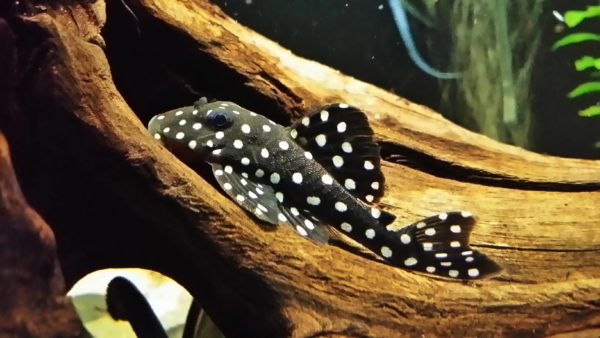
This fish looks dark. The color can be grey or fine black, with prominent white spots over its body!
The Common Pleco
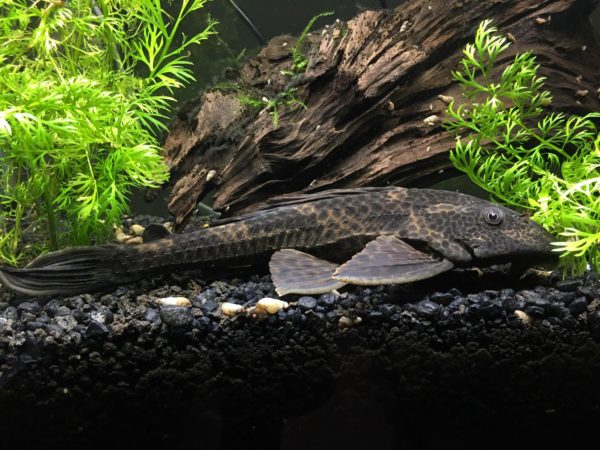
A variant of pleco has a dark brown body with prominent dark markings, and it can potentially grow up to 24-inches long!
Zebra Pleco
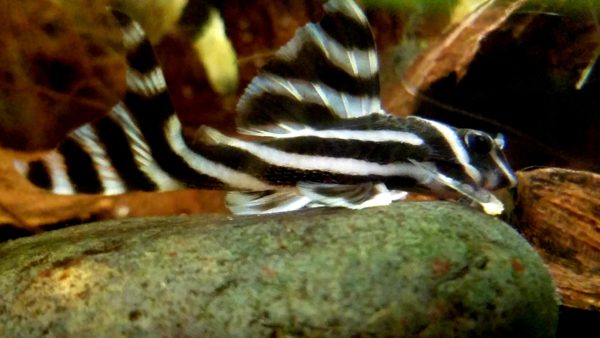
Zebra Pleco is a teeny-tiny species with stripes running all over its body.
Candy-Striped Pleco
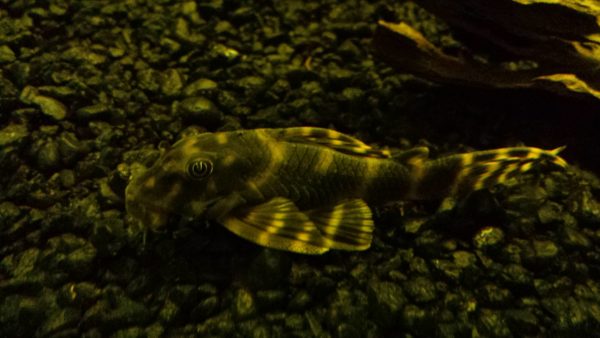
Candy-Striped Pleco looks nothing like candy, though. These fish have a pale and sand-shaded body with deep black stripes.
Vampire Pleco
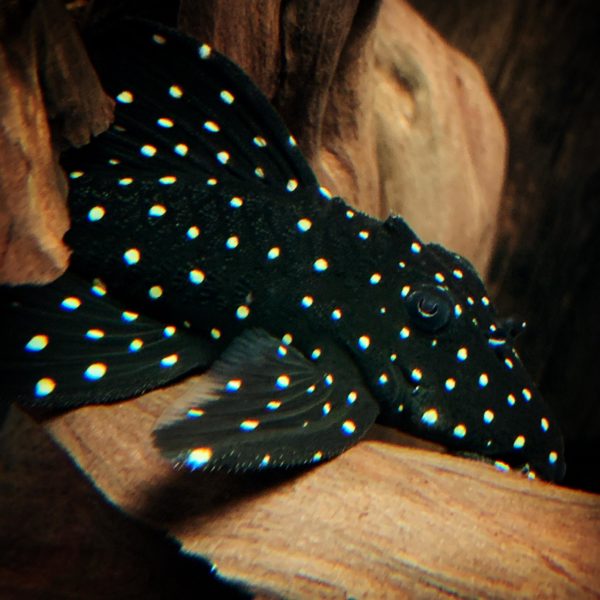
Vampire Pleco can grow up to 10 inches; it has a dark black body with bright white spots.
Bristlenose Pleco
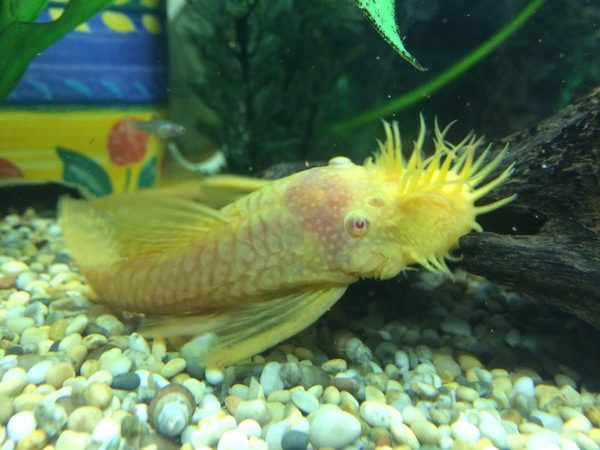
Bristlenose Pleco can grow up to 5 inches and has bristles extending from its mouth.
Sailfin Pleco
Sailfin Pleco the identification mark is its dorsal fin with over 10 rays.
Butterfly Pleco
Butterfly Pleco is available in various shades, starting from chocolate to tan, and it has symmetrical stripes running all over its body.
Gold Nugget Pleco
Gold Nugget Pleco has a brown or black body with golden or yellow markings or spots all over its body, and these fish can grow up to 9 inches in length.
Royal Pleco
Royal Plecohas red eyes, has a grayish body with stripes running all over its body, and it can grow up to 17 inches long.
Rubber Lip Pleco
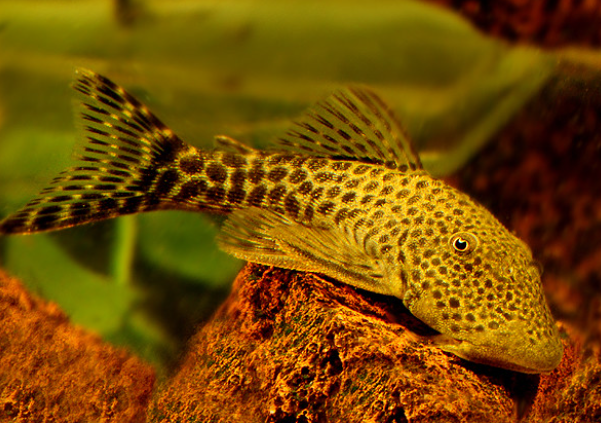
is a beautiful species with big, soft rubbery lips. And its gray color sometimes appears blueish and greenish.
Blue Phantom Pleco
Blue Phantom Pleco has an absolute cobalt blue shade and can grow up to 7.5 inches long.
The male plecos tend to grow much larger than the females, and females develop a rounder body than males. And when the plecos have stress, their color fades. They also can change their colors when hiding!
Hypostomus Plecostomus Natural Habitat and Origin
This species of catfish called Plecostomus is a pure freshwater fish that comes from the streams and rivers of West Africa and South America! It is great to keep in your tank and adapt to a wide range of water parameters!
This species thrives in brackish and freshwater and survives the seasons of drought as they can breathe through their skins and store oxygen in their bellies. If they see their natural habitat drying up, they can easily live without water for nearly thirty days. They use these thirty days searching for a new pool. It is one the most common fish globally and is currently the widespread species of the loricariidae family.
Hypostomus Plecostomus is a freshwater fish that is native to the South America region typically preferring to inhabit slow moving waters of streams and rivers. Mostly they occupy the lower reaches and falls of the river as well as the estuarine zone. The species is also known to inhibit lakes and swamps where it stays close to driftwood.
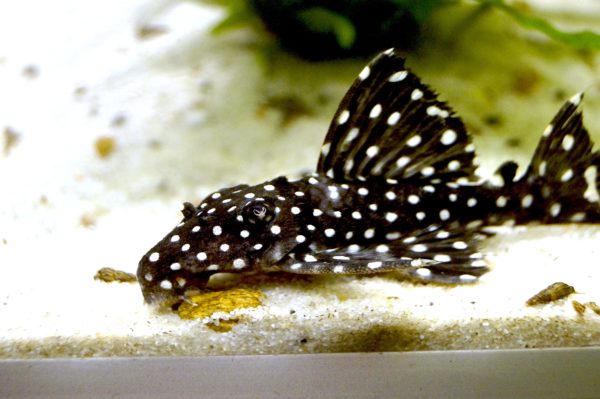
The fish also thrives in habitats where it was introduced in such as the upper basin of River Cauca in Colombia. Even though this river is highly polluted due to human industrial actions, the fish was found to be able to survive here better than the native fish that long lived there before their arrival.
To mimic their actual habitat, you may use some ornamentals and substrates! These fish species do not necessarily need substrates, as these are purely bottom dwellers and only go up to the surface once in a blue moon. Plecos love to burry; the substrate should be provided to let them do their job.
You can use clay, rocks, and some gravel to replicate their habitat!
Also, you may add some plants to your tank, as it only elevates the value of your tank and makes your fish feel they are in their natural habitat. Decorating the tank with plants does give them a nice shade, hiding spots, and acts as an always-open food source!
Word of caution – please play with plants by ripping the plants out of the substrate, so consider using hardy plants such as anubias, java ferns, and amazon sword.
Also, you can use ornamentals such as castles, shipwrecks, caves, etc. These act as great hiding places for your plecos!
As you know by now, these are purely nocturnal, and providing them with some hiding spots will help them thrive happily! You may also consider placing driftwood into the tank because it acts as a food source and as a resting place!
Hypostomus Plecostomus Care & Tank Setup
Because the fish can grow exceptionally big if you wish to keep it in a tank you will need to have a large tank. Setting a tank that is at least 50 gallons or even more is preferred. Ensure that your tank water is fresh water and very clean free of any debris that may introduce infection to your fish. For the filtration system, one that moves fast is better to provide the fish with lots of oxygen.
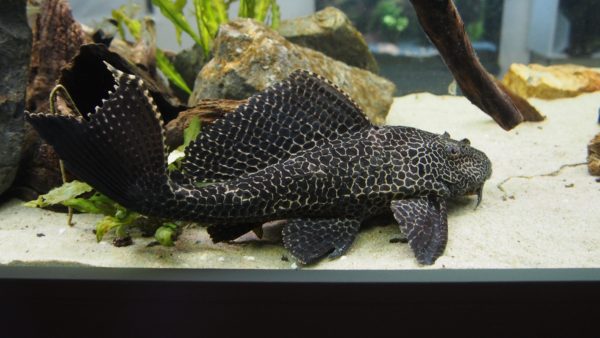
You can have a single Hypostomus Plecostomus in the tank although having pairs of them can help to alleviate boredom for them. Hypostomus Plecostomus likes to hide in dense vegetation in the wild, it is better to replicate its natural habitat with that of the aquarium. This means that you should provide it with stones to act as caves for it, and more plants in the tank.
To better learn how well to setup and keep the fish in a home aquarium, please read the following basic tank requirement:
- Ph of the tank water should be at least 6.0 to 7.5
- Temperature ranges of between 20 and 30°C
It is best to keep the top of the tank covered with a firm lid especially if the aquarium is that which is situated outdoors. This will help to avoid the possibility of the fish falling prey to birds of prey such eagles and hawks.
Hypostomus Plecostomus Tank Size And Specifications
Optimum Tank Size for Hypostomus Plecostomus
The recommended tank size for hypostomus plecostomus is 30 gallons. The best choice is 100 gallons. That’s because as it grows, it’ll need 30 gallons for each fish.
Tank Shape
Plecos need a 30-gallon tank to thrive, and most importantly you should see that the tank should be longer that its width (a rectangular tank should be fine). These fish can get bigger, and need much more space compared to teeny tiny fish.
Although, a 100=-gallon tank is an ideal tank when it comes to keeping plecos.
Filter Type
Needs to be quite strong as the water flow needs to be maintained. Also, a nice pump will be able to provide the necessary amount of oxygen.
Substrate
Clay, pebbles, gravel, etc with some caves and plants.
Water Parameters for Hypostomus Plecostomus
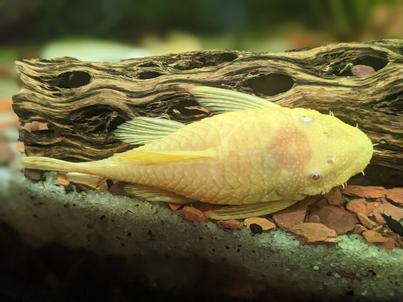
Water Temperature
The ideal water temperature for Hypostomus Plecostomus is 73-82 degrees Fahrenheit.
pH Level
The perfect water pH level for Hypostomus Plecostomus is 6.0 to 7.5.
Water Hardness
20 – 35 dkH
Hypostomus Plecostomus Tank Landscape
Best Plants for Hypostomus Plecostomus Tanks
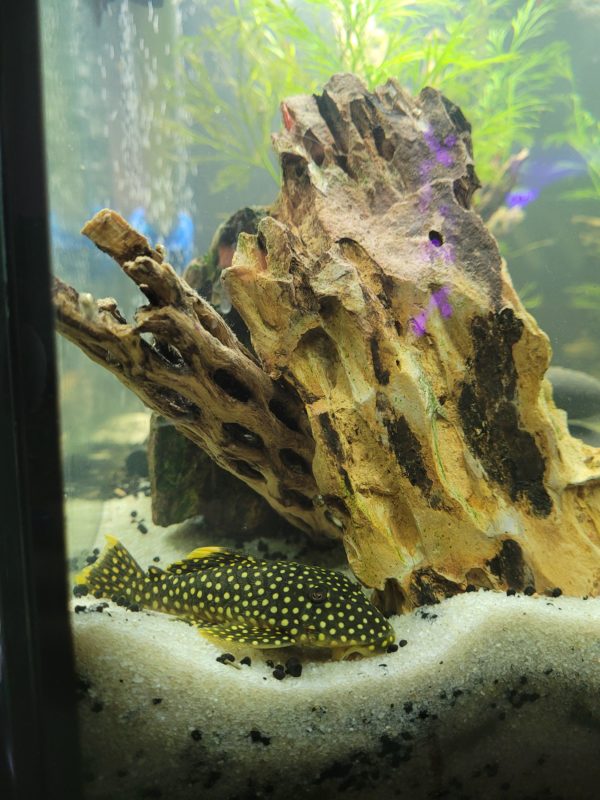
- Amazon sword
- Anubias
- Java fern
- Jungle Vallisneria
- Java Moss
Lighting for Hypostomus Plecostomus Tanks
It is better not to use artificial, natural lights will be sufficient and keep the plants healthy!
Feeding Hypostomus Plecostomus
Now comes the most important part of fish keeping! Often, beginners struggle with what to feed them and how often they should feed their fish, but you no longer have to deal with the confusion!
When it comes to Plecostomus, they are pretty opportunistic scavengers and typically feed on anything they see, be it algae, plant matter, wood, literally anything!
Feeding the fish is quite easy as it is omnivorous and will readily eat a wide variety of food it is offered. In the wild the fish is known to feed on algae, plants, invertebrates, insects, and other small fish. It can also be fed fresh or foods that are prepared at home as well. It is best however to provide the fish more plant food and give this in plenty for it to remain healthy and strong.

When you are thinking of keeping this in your tank, you must consider replicating their natural habitat. The plecos are available in different species, so you may need to consider the species before setting up your tank! For example, one may prefer driftwood, while the other may like plant matter!
Here is what you should feed your plecos. Make a nice combination of plant matter, algae, and foods such as lettuce, cucumbers, spinach, shelled peas, and zucchini!
Worms work pretty well if you wish to provide them with live foods. It is rich in nutrients and will sink from the right to the bottom, making it an excellent treat for Plecostomus.
Again, as you have already read in the article, plecos are nocturnal, so before turning the tank lights off, consider adding two pinches of their food!
To ensure the cleanliness of the aquarium water, always ensure that you remove any food debris that remains in the tank after a meal. It will help keep the tank water clean and fresh and avoid causing any opportunistic infections there.
Best Diet for Hypostomus Plecostomus
A sneek peak at some other foods that you can feed the fish in the tank includes:
- Algae wafers
- Brine shrimp
- Shrimp pellets
- No products found. (although they only need to be fed this occasionally)
- Zucchini
Hypostomus Plecostomus Behavior and Temperament
These fish are very peaceful and are a great pick for the community tanks! But, if they see competition over food, stress, breeding, and typical tank conditions, these fish can develop aggression and be very territorial.
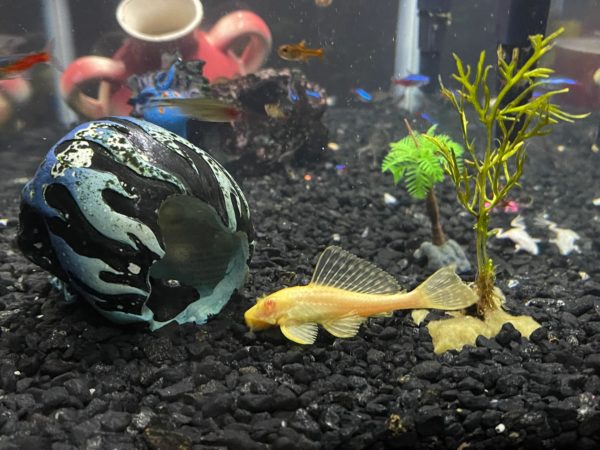
Not only that but the plecos are also known for their aggression! Plecos can be a potential threat to goldfish and discus as they suck over their slimy coats!
These fish generally spend most of their time swimming right at the bottom of your tank, and they experience a drop in water levels. They dwell on the water surface to breathe!
Plecos are nocturnal in nature and love to spend time in caves or other hiding spots during the day and come out for food when it’s night!
Hypostomus Plecostomus Tank Mates
As we have said earlier, the plecos can be very aggressive at the time, but these are pretty outgoing and social species and is one of the best choices for community tanks!
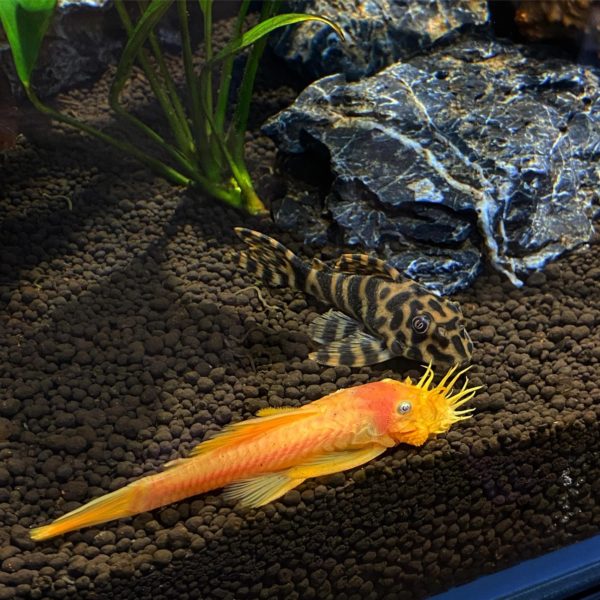
It is one of those fish that can adapt to different water parameters and is undoubtedly a good tank mate! However, there is an exception for food breeding, and the tank has more fish of their kind!
If you are looking for some tank mates, you need to avoid some species such as clown loach! These fish can throw some competition to the plecos, as loaches are pretty fast and bottom-level feeders!
Ideal Hypostomus Plecostomus Tank Mates
Except for the fish that gives off tough competition, you can keep fish like –
Or, if you wish to keep tank mates and other fish, you can opt for shrimps and freshwater crabs!
Bad Tank Mates for Hypostomus Plecostomus
And to reduce any possible aggression issues, you should have two Plecostomus in one tank! Do not unnecessarily buy a school of plecos, as things can worsen when it comes to food, breeding, etc.
Word of caution: Do not put plecos with snails, as plecos will start to see the snails as something to feed on!
Breeding Hypostomus Plecostomus
In the wild, the Hypostomus Plecostomus inhabits a river mouth and usually spawns in muddy barrows on the side of the riverbanks. To successfully breed them while they are in captivity, you may need to replicate the wild conditions for them in the aquarium. You can provide a sandy substrate where the female can lay the eggs at the bottom of the tank. Once the female lays her eggs which may number anything from 300 to 400 eggs, the male will fertilize them.
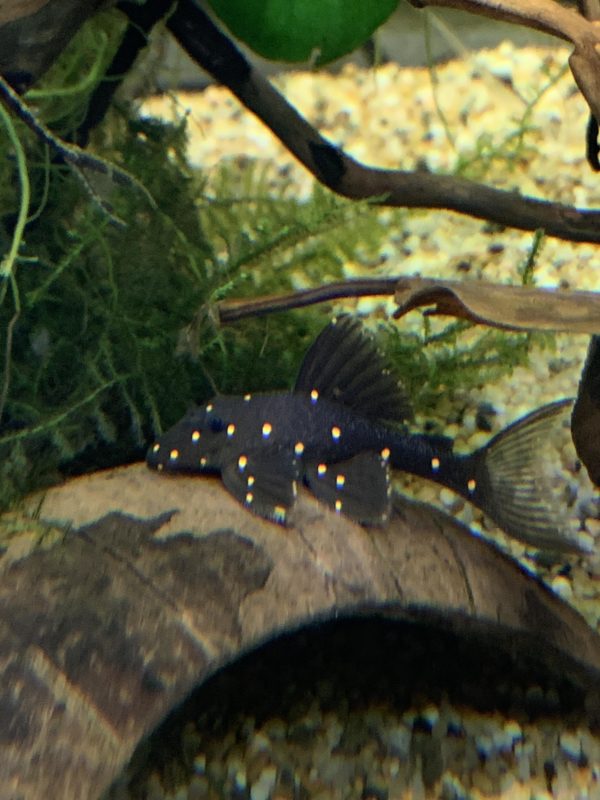
After the male has fertilized the eggs, he will guard them for around eight days until they hatch. The newly hatched fry will then feed on a mucus-like substance secreted by their parents for about a week and after which they will become independent. Please be informed that breeding the fish in an aquarium setting is very hard and may be performed by experienced keepers only.
Hypostomus Plecostomus Breeding Level – Hard
Hypostomus Plecostomus Sexual Dimorphism?
Females tend to have a more rounded body, whereas males tend to be skinnier. Females have a more rounded abdomen that is longer in relation to the rest of the body when viewed from the side. This is especially noticeable when the plecos are in breeding condition.
Hypostomus Plecostomus Common Diseases and their Treatment
Plecos have an unimaginable contribution to keeping the tank free of disease! Yes, they keep your tank clean by feeding off the leftovers and algae growing in the tank!
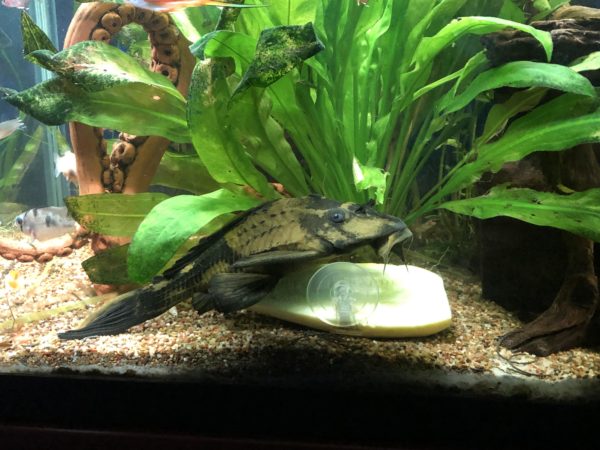
But, these fish are prone to some freshwater diseases like every other freshwater fish. Yes, a poorly maintained tank can result in causing infections and other bacterial diseases.
Ich
If your fish is infected with diseases, you will see teeny-tiny white spots over its body. Ich is primarily a parasitic disease caused by a protozoan known as Ichthyophthirius multifiliis.
The fish infected with this disease will appear pretty lethargic, have appetite loss, and constantly rub the body on the surface!
If you see such things happening in the tank, immediately isolate the fish into another tank! Add a tablespoon of salt to the water (one tbsp. salt for every 5 gallons). Salt can kill the protozoan, and increasing the water temperature by 2 degrees would speed up the process.
Bacterial Diseases
Now, when it comes to bacterial diseases, there are numerous diseases that your plecos are prone to, such as fin rot or dropsy. Though it can tolerate a variety of water parameters, it is still pretty sensitive to major water changes. And if your fish gets infected, no doubt it will die in a couple of days!
Here is how you should analyze the disease; drop will cause bloating, and you will see your fish lose its colors while infected with fin rot, which will affect your fish’s fins, making them rugged, ripped, and appear pretty milky!
Do not worry, these diseases are curable. You have to isolate the fish and renew 25% of the total water every day! Repeat this for weeks, and if you do not see its condition improving, consider seeking medication!
Facts about Hypostomus Plecostomus
- Armor Plated have bony plates instead of tails.
- Sucker Mouth – These belong to the Loricariidae family; most fish species in this family have sucker-shaped mouths. These fish use the sucker to feed and hold on to the tank surface or equipment surfaces installed in the tank.
- Algae Eaters – Even these are sold as “algae eaters,” this fish species is typically omnivorous.
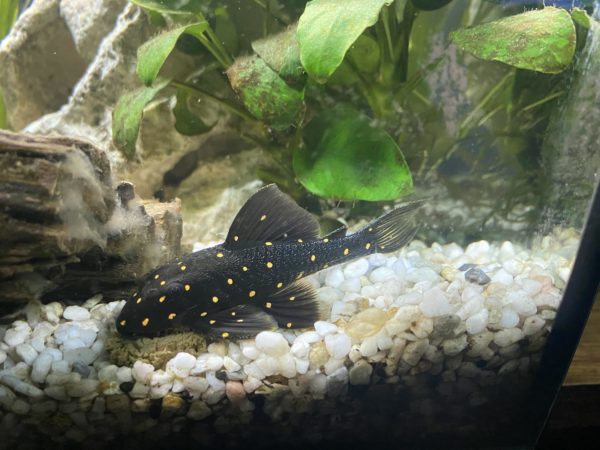
Frequently Asked Questions
Can A Pleco Eat Another Fish In My Tank?
Yes, a Plecostomus has the potential of eating a fish! But, it is also a fact that plecos will only eat a fish lying dead right at the bottom of the tank!
Do not worry, and plecos pose no harm or threat to healthy fish living in your tank! If you wish to keep them from feeding on dead fish, provide them with high-quality foods, as they crave protein.
If a pleco is hungry, it will not hesitate to feed on dead fish! Again, remove any dead fish from the tank immediately!
Can Plecos Help With Cleaning The Tank?
Just because they go by the name of tank cleaners does not necessarily mean that they have to be tank cleaners!
It is understandable for someone to think that plecos are tank cleaners, just because they tend to be bottom-dwellers!
Although they feed on algae, leftover foods, and all, they are not capable of scarping out the layers of algae from every nook and corner.
They do feed on algae and other things, but they do generate a lot of waste!
If you wish to keep your tank nice and tidy, here is what you should do –
- Install a powerful filter
- Change 10% of the water every week,
- Clean the tank once a month
- Test the water every day.
Can The Plecos Be A Good Tank Mate For Bettas?
Yes! Plecos can be a very good tank mate for bettas! Although bettas are known pretty well for their aggression, do not worry, plecos are less likely to trigger them!
Plecos are very peaceful, and due to their dull body shades, bettas will not consider them as much of a threat!
Again, the plecos are bottom dwellers and are less likely to come after bettas! Again, plecos have a gigantic size compared to bettas.
Chances are you cannot keep plecos and betta in a small tank, and you will need a bigger tank!
How To Determine If My Pleco Is Healthy?
You know your pleco is safe and healthy if you see your plecos giving you these signs:
- No loss of appetite,
- The abdomen does not appear hollow, showing around the belly
- Clear eyes; if their eyes appear a bit cloudy, you might need to isolate them
- No injuries
- No abnormal growths
- It appears nice and clean
Also, these fish are nocturnal, so do not be worried if you do not get to see them during the day. This set of behavior is normal for any pleco.
Conclusion
Plecos are great fish species. Not only are they interesting, but they are also pretty attractive! What makes them even more special is their scavenging abilities. They feed on algae, leftover foods, and other plant matter.
So, if you own a tank, you must get a pair for plecos. They help you remove the algae to some extent, but they are also a great pick for community tanks!
So, will you get yourself a pair of plecos?
No related posts.
